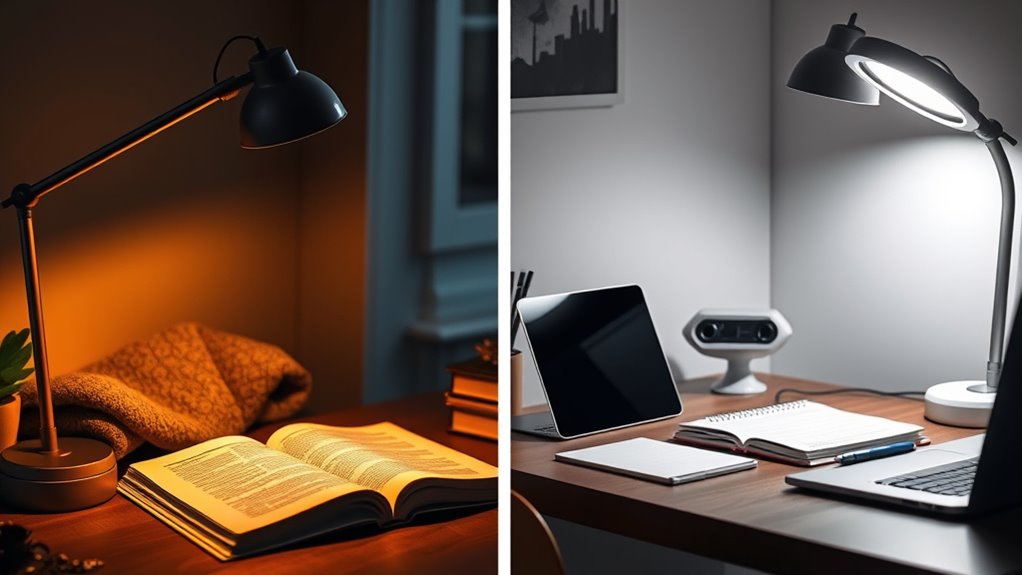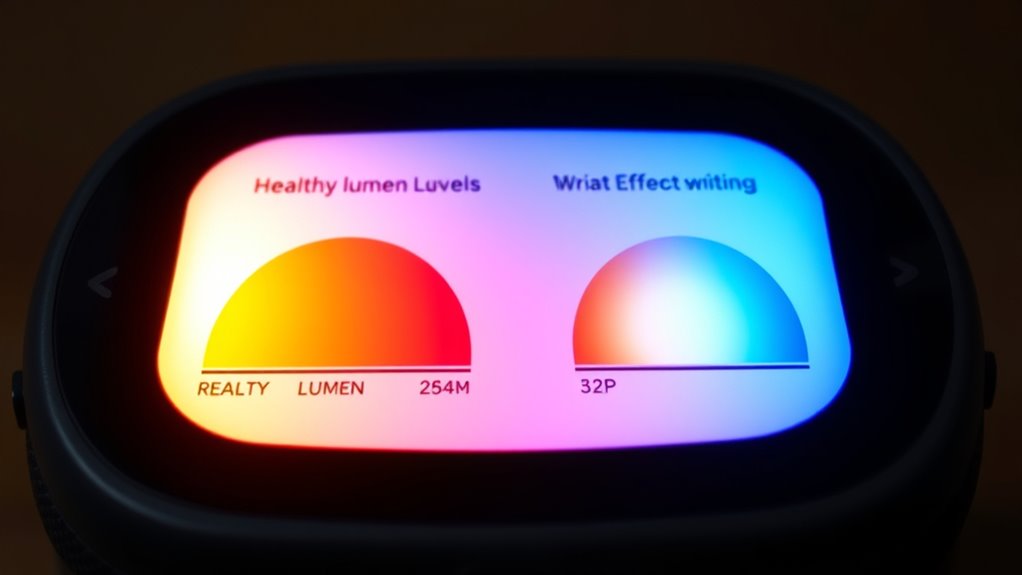For comfortable reading and writing, aim for around 300 to 500 lumens of ambient light, which supports visibility without causing glare or eye strain. Adjust your screen brightness to match your environment, avoiding extremes that can tire your eyes or cause discomfort. Proper lighting encourages good posture and reduces the need to lean or strain your neck. If you keep these tips in mind, you’ll create a healthier, more productive workspace—and there’s more to explore below.
Key Takeaways
- For reading, aim for 300 to 500 lumens to ensure clarity without causing glare or fatigue.
- Writing tasks benefit from similar lumen levels, around 300-500 lumens, to support detailed focus and reduce eye strain.
- Adjust ambient lighting to complement screen brightness, maintaining a balanced contrast ratio for comfort.
- Use adjustable lamps or diffusers to fine-tune light direction and intensity for both reading and writing activities.
- Match screen brightness to room lighting to create a comfortable, eye-friendly environment during extended use.

Have you ever wondered what lighting levels are ideal for reading or writing? Proper illumination plays a vital role in how comfortably you engage with your tasks. When you’re reading, your eyes need enough light to clearly see the text without straining. Too dim, and you may find yourself squinting or leaning closer to the screen or paper. Too bright, and glare can cause discomfort or headaches. The key is to find a balanced lumen level that supports your activity without causing fatigue.
Finding the right lighting level enhances reading comfort and reduces eye strain.
For reading, a common recommendation is around 300 to 500 lumens, which provides sufficient brightness to see details without overwhelming your eyes. If you’re working in a room with ambient lighting, it’s important to contemplate how that affects overall illumination. Adjusting your screen brightness to match the surrounding light helps reduce eye strain. When your screen’s brightness is too high relative to the room, it creates a stark contrast that can cause discomfort. Conversely, if it’s too dim, your eyes work harder to decipher the text, leading to fatigue.
In terms of ergonomic posture, maintaining the right lighting balance is essential. When your workspace is properly lit, you won’t need to lean forward or strain your neck to see better. This encourages a healthy posture, reducing the risk of musculoskeletal issues over time. Proper lighting also minimizes glare, which can force you into awkward angles or positions to avoid reflections. To optimize your setup, position your light source so it doesn’t shine directly into your eyes or reflect off your screen. Using adjustable lamps or diffusers can help achieve this.
Additionally, understanding the contrast ratio of your lighting setup can impact how comfortable your eyes feel during extended reading or writing sessions. Adjusting screen brightness is equally important. Most devices have settings to fine-tune brightness levels. You should set your screen brightness to match your environment—neither too bright nor too dim. When working in a well-lit room, a moderate screen brightness usually suffices. If your room is darker, increase it slightly, but avoid the maximum setting, which can cause eye strain. Remember, the goal is to create a comfortable visual environment that minimizes the effort your eyes need to make.
Frequently Asked Questions
How Do Lumen Levels Affect Eye Strain During Prolonged Tasks?
You might notice eye strain during long tasks if lumen levels are too high or low. Proper lumen levels help reduce glare and prevent your eyes from overworking. Adjusting color temperature can also ease strain, making the light softer or warmer. When you optimize lumen levels and choose the right color temperature, you lessen glare and fatigue, helping you stay comfortable and focused during extended reading or writing sessions.
Can Adjusting Lumen Levels Improve Reading and Writing Performance?
Imagine your workspace as a stage, where perfect lighting design highlights your best performance. Adjusting lumen levels through task-specific illumination can markedly boost your reading and writing efficiency. When lighting matches your activity, it reduces eye strain and enhances focus. So, yes, fine-tuning your lighting design with appropriate lumen levels helps you perform better, making your tasks feel effortless and more comfortable, just like a well-lit stage showcasing your skills.
Are There Recommended Lumen Ranges for Different Age Groups?
You might wonder about recommended lumen ranges for different age groups. Age-related lighting needs vary, with older individuals generally benefiting from higher lumen levels to compensate for reduced eye sensitivity. For example, younger people may find 300-500 lumens sufficient for reading and writing, while older adults often require 700 lumens or more. Adjusting your lighting to match these recommended ranges can enhance comfort and productivity.
How Do Ambient Lighting Conditions Influence Lumen Effectiveness?
Imagine a painting’s vibrant colors lost in shadows—that’s how ambient lighting influences lumen effectiveness. You’ll notice glare reduction improves visual comfort, especially in bright settings. Adjusting color temperature can make reading and writing easier on your eyes, while proper lighting enhances contrast. When ambient conditions shift, lumen effectiveness varies, so you should optimize lighting to guarantee clarity and reduce eye strain, creating a balanced, visually pleasing environment.
What Are Signs of Improper Lumen Levels Impacting Visual Comfort?
When lumen levels are improper, you might notice glare that causes discomfort or eye strain, especially if the lighting isn’t well-balanced for your tasks. You may also experience difficulty distinguishing colors or a mismatch in color temperature, making reading or writing less comfortable. These signs indicate that your lighting needs adjustment to optimize glare reduction and make certain the lumen levels support clear, comfortable vision for your activities.
Conclusion
Understanding your ideal lumen levels for reading and writing isn’t just about comfort—it’s about optimizing your productivity and eye health. Some believe that higher lumens boost focus, while others think softer lighting reduces strain. The truth? Find a balance that feels right for you. Experiment with different levels, listen to your eyes, and adjust accordingly. When you tailor your lighting, you discover better focus and long-term eye wellness—making every reading and writing session more effective.








